Today is the day. After what’s felt like an eternity with some truly bizarre cross promotion, Fantastic Four arrives in theaters. To celebrate this occasion, we asked our Marvel Rundown team a simple question; what’s your favorite Fantastic Four Story?
Some rules were set, only comics and try to avoid the obvious picks; The Galactus Trilogy, This Man, This Monster, Fantastic Four #267 (Sue Storm-Richard’s miscarriage), Fantastic Four #60 (first Waid and Wieringo issue) Solve Everything, etc.
All of these are landmark stories for a reason and if you haven’t read them, you should. But we’re the Beat’s elite Marvel experts for a reason. The history of the Fantastic Four is filled with excellent stories. It’s The World’s Greatest Comic Magazine for a reason. So we’ve compiled appropriately four of our favorite stories for you to check out and enjoy!
Our Favorite Fantastic Four stories!
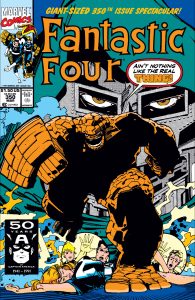 Art by Walt Simonson
Art by Walt SimonsonFantastic Four #350, 352-354
Writer/Artist: Walt Simonson
Letterer: Bill Oakley
Colorist: Brad Vancata, Marie Javins
Walt Simonson’s tenure on Fantastic Four is but a blip in the long history of the book but what a blip! Simonson has long been compared to Kirby, with his own unique brand of dynamic storytelling. So him both writing and drawing the book was a natural fit. His stories favored high science fiction ideas while playing with the family dynamic of the book. And it all culminates in these four issues. A lot of it is very specific to the time period. A human Ben Grimm wears a Thing suit! Sharon Ventura, a lady Thing going by the codename Ms. Marvel! Kristoff, heir of Doom, impersonating Doom! But Simonson being the consummate storyteller that he is makes this all so compulsively readable and exciting. Kicking off with Doom and an army of Doombots attacking Castle Doom, Ventura lured to Latveria by Doom with promises of a cure to her condition, and the rest of the Fantastic Four trying to rescue her. Issue #352 (351 is a fill in) has what is quite possibly the greatest Mr. Fantastic and Dr. Doom fist fight with one of the coolest uses of the comics medium (it involves time travel and flipping through pages). It all culminates with Fantastic Four fighting their way out of the TVA. Yes that TVA, long before Loki popularized it. Through it all Simonson makes the comics medium his putty. Not many superhero creators Few creators seemed as hellbent as he did on reminding people why the FF was tagged The World’s Greatest Comic Magazine. This story isn’t just the platonic ideal of a Fantastic Four story with its kooky science fiction, family drama, and massive action. It’s the platonic ideal of what you want out of a superhero comic. – D. Morris
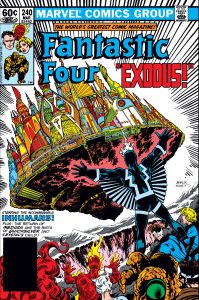 Art by John Byrne
Art by John ByrneFantastic Four #240
Writer/Artist: John Byrne
Colorists: Glynis Wein & Bob Sharen
Letterers: Jim Novak & Jean Simek
I’ve written about my pick before, during Covid, when comics weren’t weekly, we took a look back at older runs, and I wrote about John Byrne’s start on the FF. In that collection, issue #240 of the Fantastic Four, the Inhumans are dying, and the team lives up to their name by doing the fantastic, helping them. There are plenty of classic stories that show they aren’t really superheroes, rather, they are super adventurers, solving problems with a combination of intelligence, skill, and powers. After figuring out that the Inhumans are dying from civilization’s pollution, only Mr. Fantastic could come up with a plan to save them that involves moving their city to the Blue Area of the Moon. And that leads to my favorite bits of this issue when it comes down to the Thing being called on to use his skill as an astronaut to help save the day. It is only one panel, but it is so powerful that it has stayed with me ever since I read it all those years ago. – George Carmona 3rd
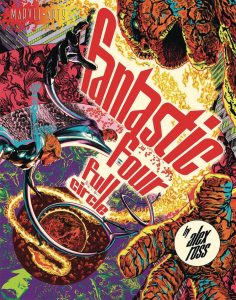 Art by Alex Ross
Art by Alex RossFantastic Four: Full Circle
Writer/Artist: Alex Ross
Colorist: Alex Ross with Josh Johnson
Letterer: Ariana Maher
Back in 2022, Alex Ross’s love letter to the Silver-age of Marvel’s First Family, Fantastic Four: Full Circle, was released as an original graphic novel after years of development. This gorgeous work of art is 64 pages of just phenomenal work. It’s no surprise as Alex Ross is an amazingly gifted artist that melds Kirby style art with classical technique. While I am not a major fan of his plotting/ writing, Full Circle does something special by taking a look at the history of the Fantastic Four. The characters have that Lee and Kirby feel about them, but without some of the more unsavory bits (ie The treatment of Sue). The fact this story commits one of my biggest pet peeves in story telling- referring to a classic story, in this case the classic Fantastic Four #51–and still somehow pulls it off is a testament to its execution. It’s some of the most experimental art Ross has ever done with several psychedelia-inspired scenes as the Four journey into the Negative Zone. It’s easily one of Ross’s best comics work and a masterclass in art and storytelling- Jordan J.
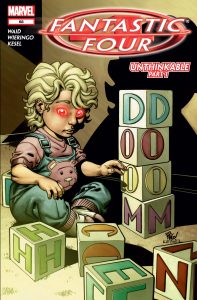 Art by Mike Wieringo
Art by Mike WieringoFantastic Four: Unthinkable (1998) #67-70, 500
Writer: Mark Waid
Artist: Mike Wieringo
Inker: Karl Kesel and Lary Stucker
Colorist: Paul Mounts
Letterer: Chris Eliopolois and Rus Wooton
Most comics fans agree that Doctor Doom is one of Jack Kirby’s greatest creations and among the great supervillains of all time. But often in the quest to lean into his nobility, creators make him too sympathetic or heroic. Mark Waid throws that all out the window and makes a declarative statement that all of the nobility and pomp is an artifice, another armor to mask his evil, pettiness, and hubris. “Unthinkable” opens with Doom sacrificing his childhood love and turning her skin into armor. He banishes young Franklin to hell and kidnaps the newborn Valeria, who he views as his only worthy heir. Throughout this story, Doom is at his most diabolical and Waid revels in his cruelty. It’s a direct contrast to the Fantastic Four, who repeatedly sacrifice for one another. We see Reed Richards here at his most raw and vulnerable. Waid focuses on the family dynamic to accentuate how isolated Doom is, and how inhuman that makes him. Up to this point in the Waid/Wieringo run the stories had been lighthearted romps that built up the familial bonds and camaraderie. That is tested here as Reed wallows in self pity. In the end, the Four are victorious and save their children but not without a steep physical cost. The art is some of the best of the late Mike Wieringo’s career. His cartoony style, with large, rounded eyes and expressive forms amplifies the drama and heartache. Over and over we see close up of characters’ eyes, revealing the shared humanity of the heroes and villains and the vast possibility for good and evil contained within. The rubbery look of the characters belies the drama. It is a style at odds with the material as if to emphasize just how grand a threat Doom is to their idylic world. Paul Mounts colors are a great match for Wieringo’s style. Mounts strips the colors to the essentials to hint at shape and volume and complement the mood. “Unthinkable” is an emotional ringer, one of the defining Doom stories, and a testament to the family bonds that make this particular team so unique among other superheroes and which provides so much potential drama. – Tim Rooney
Read The Marvel Rundown’s reviews every Wednesday here at The Beat










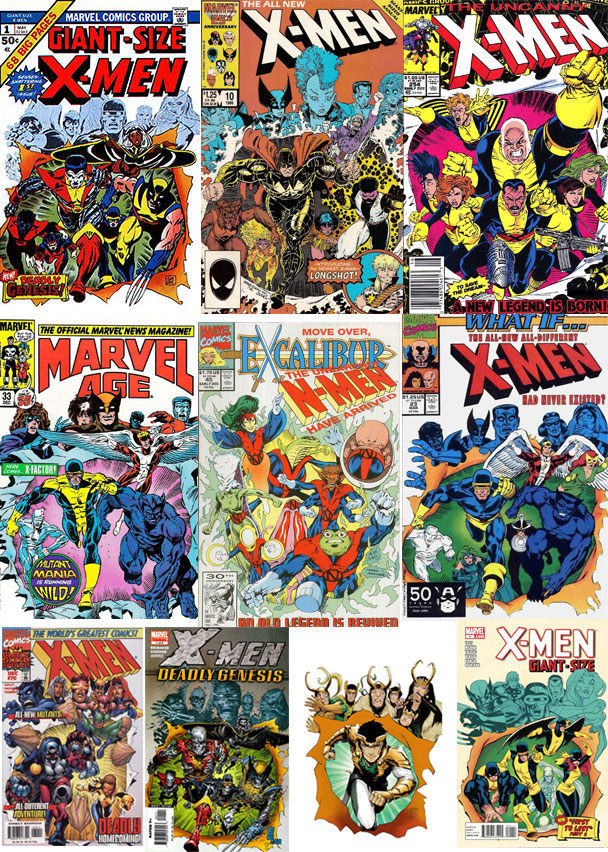







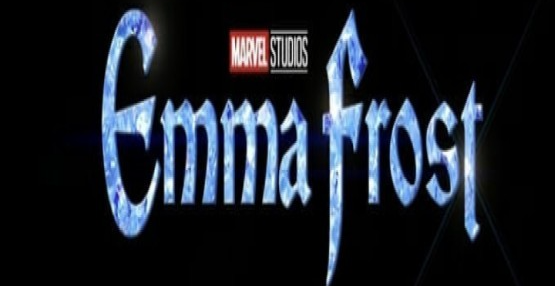
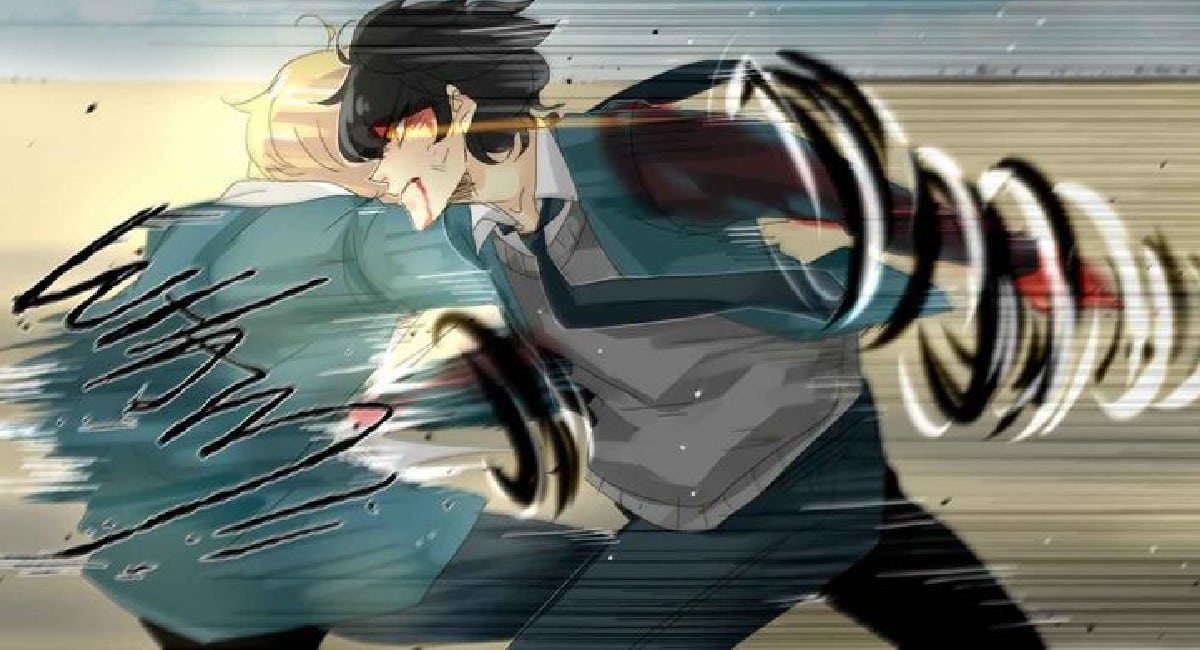
 English (US) ·
English (US) ·